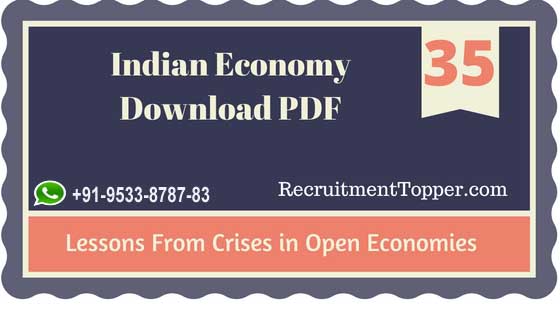Indian Economy | Lessons From Crises in Open Economies Download PDF
Contents
Genesis
Before talking about the global crisis it may be of merit to put together, in retrospect, the possible reasons, the myths around them and more importantly what could be the lessons for countries like India and also the other emerging economies. As an open economy, moving towards both convertibility as well as market-determined exchange rates are necessary, as a natural outcome, unidirectional but, slow, gradual and cautious and over a period of time.
However, these factors and openness of whether they being responsible for crises in the recent past especially, in the eighties and nineties in countries such as Mexico, Chile, SE Asian countries, Argentina soon after their opening up, cannot be conclusively said.
It can be said now that it was neither the openness, nor full convertibility nor market- determined exchange rates responsible for the crisis but:
(1) An inappropriate combination of the manner in which exchange rate was determined and convertible. That is, a pegged exchange rate and a convertible currency are incompatible. That is, if there is full convertibility then the exchange rates should be market-determined (Thailand and Argentina).
(2) Rushing into opening of the economy as the SE Asian economies allowing for all kinds of inflows, irrespective of their objective, short-term or long-term (all crises- ridden economies).
(3) Absence of monitoring mechanism over critical parameters such as CAD and DSR (S. Korea and Mexico).
(4) Lack of oversight on short-term inflows and their objective (Argentina).
(5) Utilizing short-term inflows for long-term uses which are technically flawed (Thailand).
(6) And over-investment and absence of prudential norms on lending (S. Korea).
Key Fundamentals to Openness
To summarize, as an open economy what are the key fundamentals or lessons learnt from these crises. Lesson number one, if there is full convertibility there should also be market- determined exchange rates. Number , two, there should be an oversight mechanism and not regulations on all inflows, their nature and objective, destination sector and also on the CAD and DSR levels. Number three, commercial and financial viability of projects and prudential norms of lending should never be compromised. Finally, a robust financial sector having the ability to understand risk and have risk mitigants and sufficiency of own capital to be able to absorb the risk.
It is not about returning back to an inward-looking economy. ‘There is still a larger picture, post-crisis, especially countries such as South East Asian economies, S. Korea, Russia, Chile, Argentina and Mexico, having all bounced back attracting overseas investment moving up the growth and income ladder. Their growth may have been dented in the wake of the global crisis but are now even more aggressive than before in their openness.
That is not to question the fundamentals of openness or of an open economy but to understand that future lies as an open economy, learn from their mistakes, put in checks and balances and pursue openness earnestly carving out separate niche for itself. That is, precisely what the Indian Government is presently doing. Even though China is said to be leader as an open economy but between China and India, India stands ahead on both these counts of market-determined exchange rate (even though managed) and moving towards a convertible currency.

Leave a Reply